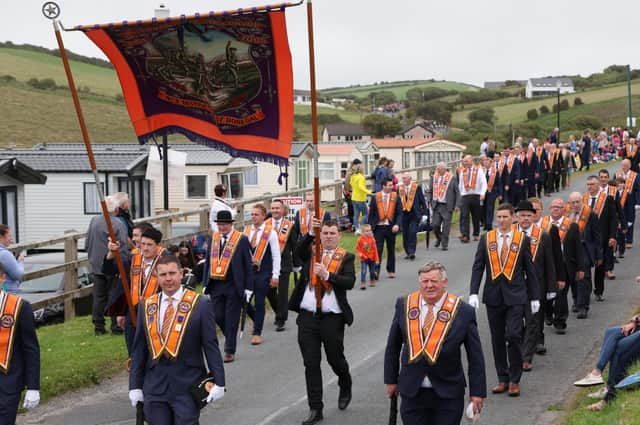Dr John Coulter: ‘Donegal dander’ at Rossnowlagh is a fine model for Orange Order parades


Now is the time for Orangeism to examine the concept if Boyne commemorations – indeed all commemorations by the loyal orders – could ever become as inclusive celebrations as Christmas and Easter.
In spite of the challenges created by Covid, the Orange Order will be marking the anniversary of Protestant King William’s victory at the River Boyne over his Catholic father-in-law, James, with a full-scale series of localised parades.
Advertisement
Hide AdAdvertisement
Hide AdAnd unlike the pandemic era, platform proceedings are back at the demonstration fields, as took place in 2019, pre-Covid.


Ireland, north and south, has suffered greatly because of the pandemic, and medical experts are still warning us about the Covid variants still on the loose.
Again, in spite of all the death and tragedy which the pandemic has inflicted on this island, can there be lessons which the Orange Order’s ruling body, the Grand Lodge of Ireland, can take from organising parades if, as a society, we have to face the reality of “living with Covid”?
My late father, Rev Dr Robert Coulter MBE, served as a Deputy Imperial Grand Chaplain in both the Orange and its senior order, the Royal Black Institution. Indeed, in the 1980s, he served a three-year term as Assistant Sovereign Grand Master of the Black.
Advertisement
Hide AdAdvertisement
Hide AdIn these various Loyal Order roles, he would make frequent trips to the Republic of Ireland to preach at annual divine services in churches. Likewise, as a Presbyterian minister, he also preached in numerous churches across the Donegal Presbytery for several years.
In spite of the legion of loyal order events he attended during his lifetime, there was one occasion he chatted about perhaps the most to me - the annual pre-Twelfth demonstration at Rossnowlagh in County Donegal.
The Rossnowlagh demonstration was held in that picturesque coastal village on the Saturday before July 12 and was hosted by the southern Irish border county lodges to allow them to attend the main Twelfth demonstrations in Northern Ireland on July 12 itself.
The parade route was neither long nor contentious. In my various writings on the event, I have often referred to it as the “Donegal dander”.
Advertisement
Hide AdAdvertisement
Hide AdPipe and silver bands, rather than the traditional northern-based flute bands – often known as blood and thunder bands – are the order of the day. There are no political speeches, and the platform proceedings take the form of a purely religious service.
And no trip to the Rossnowlagh ‘Twelfth’ would be complete without an ice cream and another dander along the village’s beautiful beach.
In spite of the long drive from our home in the County Antrim hills to Rossnowlagh as dad was the guest preacher that Saturday, dad and I could not fail to appreciate the relaxed family atmosphere of the Rossnowlagh demonstration.
Perhaps this is the reason, pre-Covid, that the Rossnowlagh event grew in popularity over the decades as an increasing number of northerners have attended the County Donegal Grand Orange Lodge’s prestigious outing.
Advertisement
Hide AdAdvertisement
Hide AdIn short, could the “Rossnowlagh model” be used as a blueprint, not just for future parades in Northern Ireland, but to increase the number of loyal order parades in the Republic of Ireland? The two key pillars of the success of Rossnowlagh are a short parade route, and only a religious service.
The vast majority of unionists and loyalists view the Northern Ireland Protocol as a threat to their British identity. But for generations, many of those same unionists and loyalists have seemingly ignored their rich southern Irish culture.
Put bluntly, half of the key battles referred to in that famous marching tune, The Sash, took place in southern Ireland. The Boyne of 1690 was at County Meath, while the decisive and exceptionally bloody battle of Aughrim in July 1691 was fought in County Galway.
Again, put bluntly, how many unionists and loyalists have regularly visited – or even once – the excellent Battle of the Boyne Visitors Centre at Oldbridge in Co Meath?
Advertisement
Hide AdAdvertisement
Hide AdAs a location for a fantastic family fun day out, the River Boyne, and especially the facilities of the visitors centre, is exceptionally highly rated.
If the Orange’s ruling body calls itself the Grand Lodge of Ireland, then it should be giving more recognition to organising Rossnowlagh-style parades south of the Irish border. Could the “Donegal dander” be one way of making the Twelfth celebrations more inclusive for all sections of the community?
In helping the economy of the island recover in a “living-with-Covid” society, how much money could be generated for local businesses if another Sham Fight – traditionally organised by the Royal Black Institution in Scarva village each July 13 – could be staged annually at Oldbridge in Co Meath?
In spite of the terrible pain of the pandemic, the loyal orders have been handed a gift horse in the battle to make their events more inclusive – culturally, historically, spiritually, and family-wise. Hopefully, they will have the good sense to seize this opportunity and implement a future “Rossnowlagh model”.
Advertisement
Hide AdAdvertisement
Hide AdDr John Coulter has been a journalist in Northern Ireland since 1978, including for the News Letter
See also